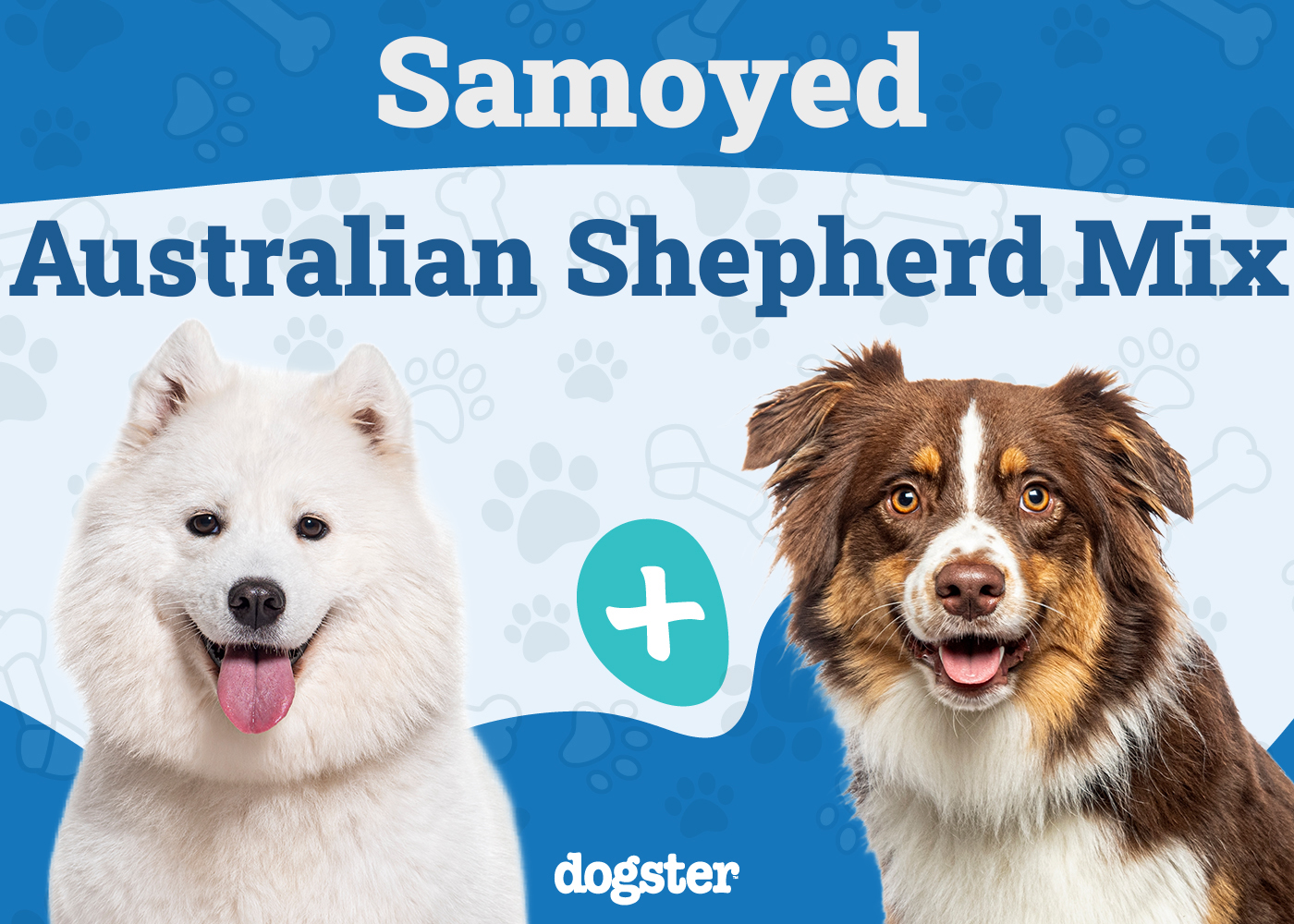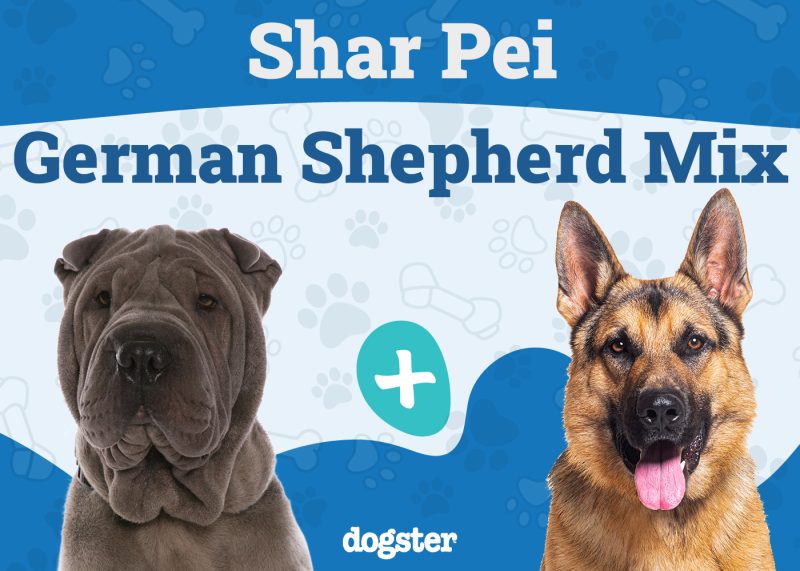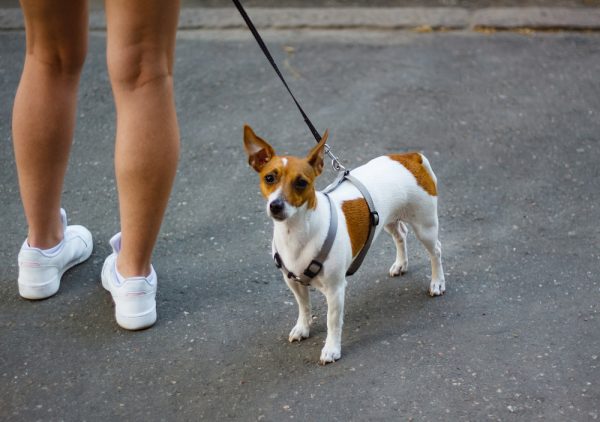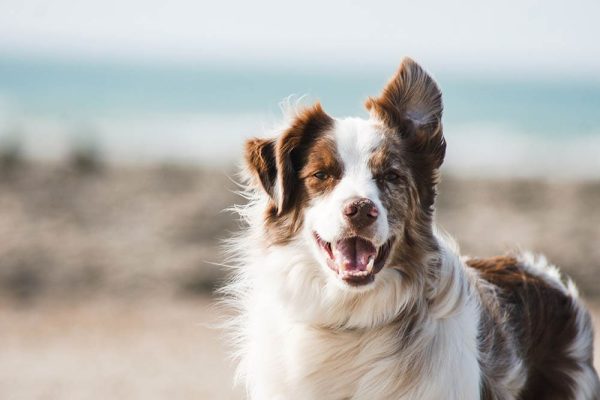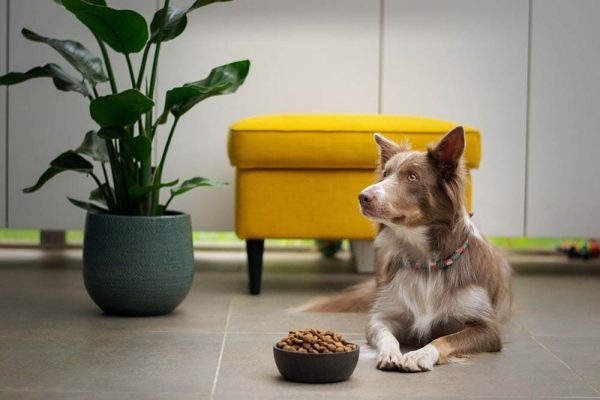In this article
View 8 More +A Samoyed Australian Shepherd mix is a rare crossbreed that comes from mixing a Samoyed with an Australian Shepherd. These hybrids will inherit traits from both parents. Therefore, you never know exactly what you’re going to get. Their appearance can be exceptionally diverse.
However, we can make a few general observations about this breed.
Breed Overview
Height:
18–24 inches
Weight:
40–75 pounds
Lifespan:
10–14 years
Colors:
Varies widely
Suitable for:
Active families with plenty of time on their hands
Temperament:
Friendly, intelligent, energetic, protective, affectionate, social
It’s important to keep in mind that these dogs can vary a lot. Therefore, some of them may be medium-sized, while others can be exceptionally big. Most are at least somewhat protective, but some may not be protective at all.
Below, we’ll explore what you can expect from this mixed dog breed, while keeping in mind that they can vary widely.
Samoyed Australian Shepherd Mix Characteristics
Samoyed Australian Shepherd Mix Puppies
As you might expect, these puppies are small bundles of energy. They’re often very playful and active, making them a bit too much for some dog owners. However, if you’re looking for a very active, playful dog, then this breed works out great. They’re often quick learners and easy to train, so we recommend you start training them early. They’re often eager participants in training and socialization, making them a bit easier to train than other breeds.
Finding a puppy is exceptionally challenging, though. There aren’t many breeders that specialize in the Samoyed Australian Shepherd mix, so most puppies happen by accident. They also aren’t readily available at most rescues or local shelters. Your best bet is to seek out a reputable breeder, but plan on waiting for a time and traveling far (unless you’re one of the lucky few).
As always, it’s crucial to pick a breeder that is responsible and ethical.
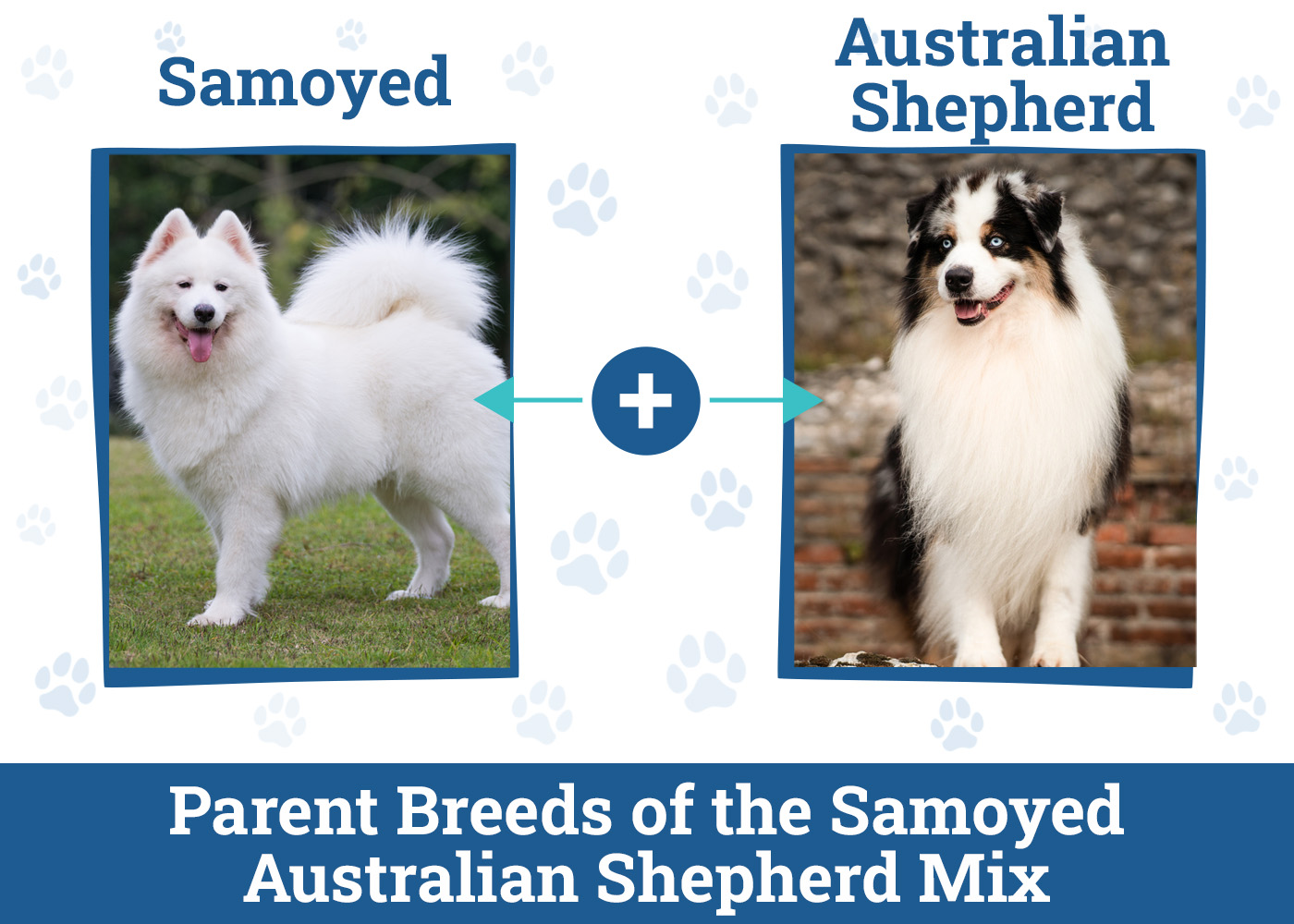
Temperament & Intelligence of the Samoyed Australian Shepherd Mix 🧠
The temperament of these dogs can vary widely. However, they are often friendly and sociable. In many cases, they will be outgoing, especially when socialized early. That said, they often form strong bonds with their owners and can be exceptionally loyal.
Sometimes, this loyalty comes out as protectiveness. However, this breed shouldn’t be aggressive when properly socialized. It’s important to get them around lots of other people and animals at a young age, though, to ensure that they understand that not everyone is a threat. This breed is usually very energetic and playful. They usually love interactive games and may bond primarily through play. Often, they keep many of their puppy-like attributes far into adulthood.
Both Samoyeds and Australian Shepherds are known for their high intelligence, and this mix inherits that trait. They are quick learners and can excel in various types of training and tasks. They’re often very good problem solvers. They may figure things out that you’d rather they didn’t, like opening door knobs or accessing off-limits food.
It’s important to understand that more intelligent breeds are often more work. For instance, due to their intelligence, they require plenty of mental stimulation each day. Otherwise, they can become bored and try to make their own fun, which often involves chewing and getting into things.
Are These Dogs Good for Families?🏡
These dogs can make great family pets under the right circumstances. They are often very playful and energetic. For some, this may be a good thing. However, for others, it can make these dogs hard to keep up with.
Luckily, they are friendly and sociable, which is a big plus in almost anyone’s book. They can also be loyal and protective of their family, which some dog owners will like. Their high intelligence and eagerness to please make them trainable, which is beneficial for families looking for a well-behaved dog. However, this also comes with more work, as they require more mental stimulation.
Additionally, early socialization and consistent, positive reinforcement-based training are essential to ensure they develop into well-behaved family members.
Does This Breed Get Along with Other Pets?
When properly socialized, this breed can get along with other pets. You should introduce them to other pets at a very young age—preferably as soon as they get their first round of puppy shots. Early exposure to different animals and positive interactions can help them be more comfortable and tolerant around other pets. As a mixed breed, their temperament can vary widely, including in how they interact with other pets.
Because this breed is part Australian Shepherd, they may develop some herding instincts. These may cause the dog to “herd” other pets. This isn’t necessarily something that can be trained out, as it is part of the dog’s nature. That said, some mixed dogs may not have these instincts at all.

Things to Know When Owning a Samoyed Australian Shepherd Mix
Food & Diet Requirements
For the most part, this breed doesn’t have any special dietary needs. However, larger animals should preferably eat a diet designed for larger canines. Larger dogs simply have differing dietary needs than smaller dogs, especially when it comes to joint health.
When your canine is a puppy, it’s especially important to feed them food formulated for larger dogs. Otherwise, they may be at a higher risk of developing hip dysplasia and similar joint problems.
Always choose a food that is suitable for your dog’s age. Puppies that are still growing need food formulated for puppies, while adults need food formulated for adults. You don’t have to switch to senior food at a certain age, though. It mostly depends on when your dog needs the added benefits of the senior food.
We recommend keeping track of your dog’s health and adjusting their portion sizes as necessary. If your mixed dog is very active, they may need high-calorie food. On the other end of the spectrum, dogs that aren’t very active may need diet food. Be cautious with treats, which can add extra calories and contribute to weight gain.
Exercise
The Samoyed Australian Shepherd Mix is exceptionally active, so they need plenty of exercise. You should aim for at least 60–90 minutes a day. This may include a variety of activities, including walks and playtime. These dogs also need mental stimulation, so look for activities that do both.
While these dogs do need lots of exercise, you shouldn’t force them to exercise, especially when they are puppies. Forced exercise can cause joint injury and other issues, leading to hip dysplasia and arthritis. Always follow your dog’s cues for the amount of exercise they need.
Just like people, some dogs will be more in shape than others. If your dog hasn’t been on an exercise routine in a while, start small and work your dog up to the recommended daily exercise.
Training
These dogs are exceptionally easy to train. They require patience, consistency, and positive reinforcement, though. Their willingness to learn makes it pretty easy to keep their attention during training, but we still recommend keeping sessions short. You should start training your dog relatively early, preferably as soon as you bring your puppy home. Start socialization as early as possible, too. Early exposure to many different people and animals will help your dog stay a well-adjusted adult.
We highly recommend getting your puppy involved in puppy classes as soon as they are old enough. These classes help them learn basic commands and provide a safe place for them to socialize. Private lessons aren’t recommended unless your dog needs help with something very specific or cannot be around other dogs for one reason or another.
Be consistent with commands, rules, and expectations. Use the same cues and signals for specific behaviors to avoid confusion. Get everyone in your house to use the same cues, too. This helps prevent confusion.
Due to their high intelligence, you’ll probably want to keep training these dogs even after you’ve taught them everything they need to know. We recommend looking at tricks and other fun commands whenever your dog has mastered all the must-known cues. Consider advanced training or agility courses to challenge their intelligence and physical abilities further. They often excel in agility and obedience competitions.
Grooming ✂️
Grooming a Samoyed Australian Shepherd mix can be a huge task, though it depends on the exact type of coat they inherit. They will have a double coat, as this is a trait shared by both their parents. This double coat will shed regularly and can mat. Therefore, you’ll need to brush them at least several times a week. They may shed particularly badly in the spring and fall when more grooming is often called for. Use an appropriate brush for the best results, like a slicker brush or undercoat rake.
You should also bathe your canine, though not all that often. Typically, every 2–3 months is plenty of bathing for this breed. Over-bathing can cause the dog’s coat to become stripped of natural oils, leading to damaged fur and excess shedding. You should also check their ears regularly. Signs of infection, wax buildup, and foreign objects may be a sign to call the vet. You may need to clean their ears regularly, too.
Because long nails can be uncomfortable, it’s recommended to keep their nails quite short. You can do this yourself at home or have a professional groomer take care of it for you. Dogs also need their teeth cleaned regularly. Brush their teeth at least twice a week, though preferably more. You can also use dental chews and toys to help reduce tartar buildup.
Health and Conditions
Mixed-breed dogs are often healthier than purebred dogs. They inherit their traits from a larger gene pool, so rare, recessive conditions aren’t as likely to pass onto them. However, that doesn’t mean these dogs aren’t prone to any diseases. They’re most prone to hip dysplasia, which is a common condition for most large breeds. It occurs when the hip joint doesn’t develop correctly, leading to arthritis at a very early age. Diet, genetics, and exercise all play a role in this condition.
This breed may also be prone to various eye problems, including cataracts, PRA, and corneal dystrophy. Skin allergies can also develop which may lead to itching, rashes, and skin infections. There are many ways to manage this skin condition, including medication, extra grooming, and avoiding the allergen as best as possible.
- Skin allergies
- Deafness
- Hip dysplasia
- Eye problems
- Hypothyroidism
- Bloat
- Epilepsy

Male vs. Female
Because this mixed breed varies so widely from dog to dog, there aren’t any overarching differences between genders that we can point out. There simply isn’t enough consistency in this mixed breed, since they can inherit any trait from either of their parents.
Males are sometimes larger than females. However, even males can vary from 40 to 75 pounds, so there are plenty of females that are bigger than males, too.
3 Little-Known Facts About the Samoyed Australian Shepherd Mix
1. They can have very different coat textures.
While this mix often inherits the thick double coat of both parent breeds, the texture of their coat can vary widely. Some individuals may have a softer, fluffier coat like a Samoyed, while others may have a sleeker and denser coat like an Australian Shepherd. This diversity in coat texture can make grooming and maintenance requirements different for each dog.
2. Herding instincts may be present.
Australian Shepherds have exceptionally strong herding instincts. Therefore, these instincts may be present in this breed occasionally. These instincts may make them harder to keep with small children and other pets, as they may try to herd them.
3. They are very active!
Both parent breeds are known for their agility and intelligence. This mix often inherits these traits, making them highly capable in dog sports and activities like agility, obedience, and even herding trials. They can excel in these areas with proper training and exercise, making them a great choice for active individuals and families who enjoy participating in dog sports.

Final Thoughts
The Samoyed Australian Shepherd mix is a rare mixed breed that varies widely. You never know exactly what you’re going to get with this mixed breed, so it’s important to keep an open mind. If you’re looking for a very particular dog breed, you’re best off getting a purebred dog, which tends to have more set-in-stone traits.
We recommend this breed primarily for very active families. You’ll also need plenty of time to commit to their exercise and grooming needs, which can be substantial.
See Also:
- Samoyed Chow Chow Mix: Pictures, Care, Info, & More
- Samusky (Samoyed Husky Mix): Pictures, Care, Info & More
